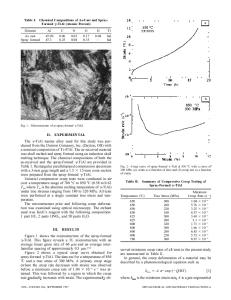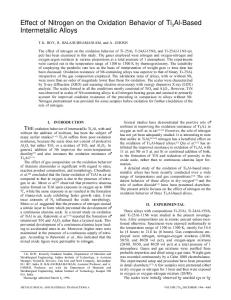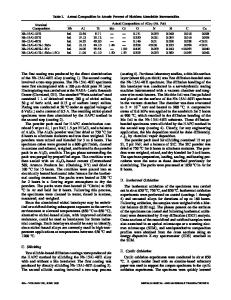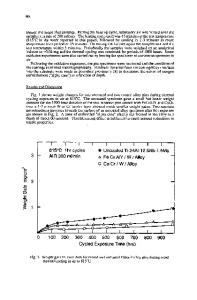Oxidation Behavior of Intermetallic Titanium Aluminide Alloys
- PDF / 573,705 Bytes
- 12 Pages / 432 x 648 pts Page_size
- 17 Downloads / 389 Views
Oxidation Behavior of Intermetallic Titanium Aluminide Alloys Michael Schütze1, Simone Friedle1 1 Dechema-Forschungsinstitut, Theodor-Heuss-Allee 25, 60486 Frankfurt am Main, Germany
ABSTRACT Above 750-800°C oxidation becomes a serious life time issue for the new group of intermetallic light-weight high temperature alloys based on titanium aluminides (TiAl). Fast growing titanium oxide competes with protective alumina as a surface scale in the oxidation reaction by which the formation of a slow-growing protective oxide scale is prevented. The key to the development of alloys with sufficient oxidation resistance is the understanding of the thermodynamic and kinetic situation during the oxidation process. The latter is influenced by the type of alloying elements, the Al- and Ti-activities in the alloy, the oxidation temperature and the environment (e.g. dry or humid air, etc.). This paper provides a comprehensive summary of the oxidation mechanisms and the parameters influencing oxide scale formation. Besides the role of metallic alloying elements, the halogen effect will also be discussed. The paper finishes with recent results concerning the prevention of oxidation-induced room temperature embrittlement of TiAl alloys. INTRODUCTION The oxidation behavior of intermetallic J-based titanium aluminides alloys as a new group of high temperature lightweight materials has been an issue since the first investigations of their properties [1-3]. Over the years the development of technical versions of these alloys has been focused on base compositions with aluminum contents in the range of 40-50 at.%, i.e. the microstructure is defined by J-TiAl as the major phase and D2-Ti3Al as a second phase whose amount depends on the aluminum content. While there are also alloys with aluminum contents lower than 40 at.%, such as Ti3Al and orthorhombic titanium aluminides, this paper focuses exclusively on those with an aluminum content of at least 40 at.%, which are simply called TiAl alloys throughout the text. Concluding from oxidation results of commercial nickel- and iron-based alloys, one would expect that aluminum contents of 40 at.% and more should be sufficient to form a protective slow-growing alumina scale in air during high temperature exposure [4]. Such a scale suppresses rapid oxidation and therefore reduces metal consumption. However, due to thermodynamic and kinetic reasons (for details see below) in most cases a mixed scale containing fast growing titania in addition to alumina is formed. At least for temperatures of up to 650°C, virtually all TiAl alloys reveal a sufficient and reliable oxidation resistance. By adding further alloying elements to the bulk material, a reasonable oxidation resistance can be achieved for temperatures of up to 850°C [5,6]. Future operation conditions of TiAl alloys, however, envisage maximum temperatures of up to 900°C and 1050°C in jet engines and for automotive turbocharger rotors, respectively, at which special non-conventional surface treatments are required in order to maintain an adequ
Data Loading...











